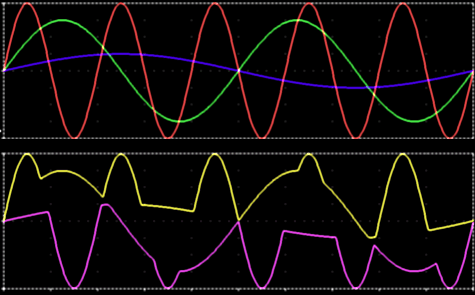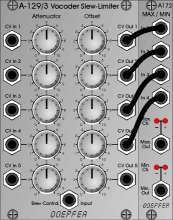A-172 Maximum /
Minimum Selector / Rectifier
nicht mehr lieferbar / no
longer available
|
|
A-172 ist ein Minimum/Maximum-Modul und besitzt
vier analoge Eingänge und zwei analoge Ausgänge (Minimum, Maximum). Die
Hauptanwendung des Moduls ist die Verarbeitung/Vermischung von analogen
Steuersignalen, wie z.B. Zufallsspannungen (Random), ADSR, LFO, S&H, Ribbon-CV, Theremin-CV
usw.). Das Modul kann aber auch zur Bearbeitung von Audiosignalen (z.B.
Ausgänge von einem oder mehreren VCOs) verwendet werden.
Das Modul entnimmt den 4 Eingängen zu jedem Zeitpunkt jeweils den maximalen bzw. minimalen Wert
und gibt diese an den beiden Ausgängen
aus.
Um die Signale unabhängig voneinander mit Abschwächer und
Offset-Regler auszustatten (d.h um jedes der Signale in die richtige
"Position" mit der gewünschten Amplitude zu bringen), wird die
Verwendung eines A-129-3
Slew-Limiter/Abschwächer/Offset-Generator empfohlen. Siehe hierzu auch das
untenstehende Patch-Beispiel.
Die andere untentehende Skizze zeigt die prinzipielle
Funktion des Max/Min-Moduls am Beispiel von 3 Sinussignalen mit
unterschiedlicher Frequenz und unterschiedlichen Amplituden.
Das Modul kann auch als einfacher Einweg-Gleichrichter verwendet werden.
Die deutsche Bedienungsanleitung ist als PDF-Datei auf unserer Website verfügbar: A172_anl.pdf
A-172 is a minimum/maximum selector module and is
equipped with four analog inputs and two analog outputs (minimum, maximum).
The main application of the module is the processing/mixing of control voltages,
e.g. random voltages, ADSR, LFO, S&H, ribbon CV, theremin-CV
and similar, but even for audio signal processing the module can be used (e.g.
several outputs of the same or different VCOs).
The module permanently picks the maximum resp. minimum voltage out
of the four input signals and outputs these voltages to the maximum resp. minimum
jack socket.
To adjust offset and amplitude for each input independently (i.e.
to bring the signal into the right "position" with the desired
level) we recommend to combine the module with the A-129-3
Slew Limiter/Attenuator/Offset Generator (see patch example below). The
other sketch below shows the basic principle of the
max/min module by means of three sine waves (e.g. three LFOs) with different
frequencies and different levels.
The module can be used also as a simpe half-wave rectifier.
For more detailed information please look at the English user's manual A172_man.pdf
Tiefe/Depth: 30 mm (gemessen ab der Rückseite der Frontplatte / measured from the rear side of the front panel)
Strombedarf/Current: +10mA (+12V) / -10mA (-12V)
The price in US$ depends upon the exchange rate between Euro and US$ at the payment day.




